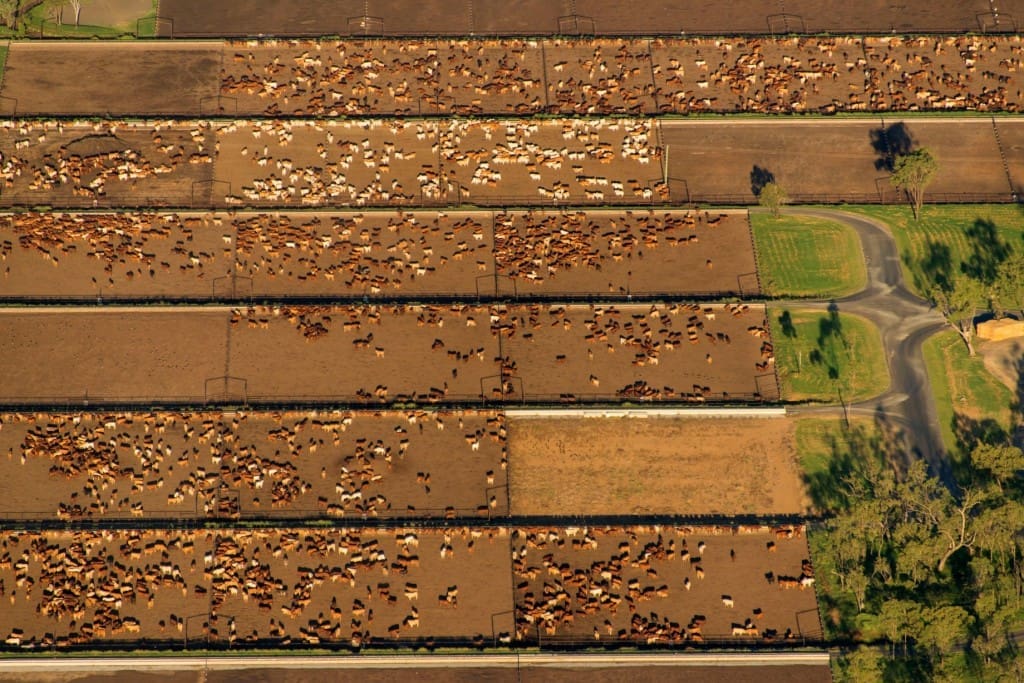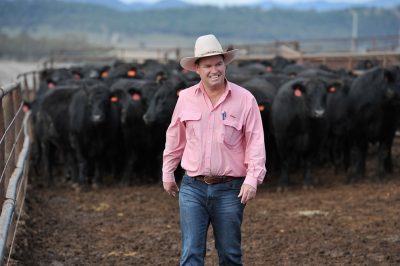
COMMERCIAL feedlots across eastern Australia are dropping numbers rapidly, as skyrocketing feeder cattle prices driven by short supply and an abundance of new paddock feed fail to align with softening grainfed meat markets across the world.
A quick ring-around survey of some of the largest yards in Queensland and NSW yesterday suggests many yards are now 15-25 percent below occupancy levels seen up to the start of the rain event in January/February, and some may drift lower.
The trend is widespread, but not universal, it appears. Some yards that feed only for a handful of permanent clients for so-called ‘program’ business directed into proprietary brands have not yet been as badly affected.
Most yards reporting declines are simply not re-filling pens once each mob closes-out after doing their time, responses to inquiries made by Beef Central suggest.
Empty feedlot pens have been a rare sight across eastern Australia for the past two years, driven by the high rates of turnoff and the deployment of feedlots as a drought mitigation tool. Some yards were operating at, or beyond, their licensed capacity last year, feeding everything from young cattle to cull cows as conditions deteriorated and paddock feed ran out. As a consequence, December quarter numbers on feed across Australia hit a record 1.239 million head – completing eight consecutive quarters with numbers above a million head.
But 2020 is now shaping up to be a completely different story, as more feeder type cattle return to the paddock to utilise available grass, and feeder pricing hits ‘prohibitive’ levels – in the context of what international beef markets are prepared to pay for the finished product, and what most processors are prepared to offer for grain-finished cattle.
As an example, one of the largest feedlots in Australia, located in southern Queensland, has seen numbers on feed decline from 57,000 head to 41,000 over the past two months – a 28pc operational decline. Induction numbers at the yard that are normally 450-500/day are this week at 140-odd per day, Beef Central was told by a source close to the business.
Another very large Darling Downs feedlot which asked not to be named is now operating 17pc behind where it sat in January, but said operating numbers had now ‘plateaud’, for the timebeing, at least.
A senior manager at the yard said his business was looking for higher price signals from grainfed processors in order to have any confidence to begin re-building numbers in the back half of the year.
But that is now looking increasingly unlikely, given the current extremely flat state of export meat markets across Asia, North America and other regions.
In addition to the direct impact in China, coronavirus is now having a profound impact on red meat demand in Japan, Korea, Singapore and other markets including the US, where food service demand (hotels, restaurants, functions and catering) has been hard-hit by public concerns and actions over coronavirus, and the general impact on local economies.
Beef City grainfed kills slashed
JBS Northern division’s chief operating officer Anthony Pratt confirmed to Beef Central this morning that his company’s Beef City dedicated grainfed processing plant neat Toowoomba will drop 1000 grainfed cattle each week (equivalent to 200 head per day) from its kill rosters from early April.

JBS Northern COO, Anthony Pratt
That reduction will involve not only cattle fed at the adjacent Beef City feedlot, but also other grainfed cattle bought by JBS from other yards, for processing at the site.
Mr Pratt anticipated the cutback would last for the “rest of the year, at least.”
“Given the trading conditions, we think almost all feedlots are going to carry less cattle over the course of this year,” he said.
“Quite a number of our regular grainfed cattle suppliers are telling us they are not going to have the normal volume of supply available, as the year wears on. That, in turn, is forcing us to make some hard decisions to align our business with available supply.”
While some of the Beef City grainfed turnoff is locked into program business underpinned by brands for specific customers, a considerable percentage is still sold on the open market as 100-day grained beef to markets like Japan and Korea. It is this portion which will be impacted most by cutbacks in grainfed processing throughput.
“We are in direct competition with grainfeeders in the US in markets like Japan and Korea, and price and volume wise, Australia is currently under a lot of pressure from these competitors,” Mr Pratt said.
“We just can’t bury our head in the sand and hope things will improve. We need to makes some hard decisions,” he said.
“Overall, the supply of finished cattle – both grain and grassfed – is going to be pretty ugly right across eastern Australia, as the year wears on.”
Killara follows cattle declines
General manager of Elders’ Killara feedlot near Quirindi in northern NSW, Andrew Talbot, is facing the same challenges in his yard.
He said Killara was back about 15 percent on ‘house full’ signs that were up last year.

Killara feedlot general manager Andrew Talbot
“There’s no doubt that feeder cattle prices above 400c/kg are creating real concerns for the industry,” Mr Talbot said.
“While paddock grids for black feeder steers are currently around that mark, in the general market and via AuctionsPlus, they are making well over that,” he said. “Importantly, those cattle are not going to established supply chains, but more to grass fatteners and speculators.”
“The problem is that the spike in the Australian cattle markets at present is purely being driven by grass fever. It’s a perfect storm, but it’s a very dangerous storm, because it’s happening at the same time that similar product in the US is getting cheaper and cheaper.
That was being driven by the fact the US has completed its herd rebuilding cycle, there are record numbers of cattle on feed, continuing softening in commodity prices and an expectation of a massive corn crop this year.
“Australian beef does not operate in a bubble,” Mr Talbot said. “It operates in a global market environment for beef, and unfortunately, given the extensive rain that’s occurred recently and the panic buying that’s emerged among restockers who now have some grass, it’s seen an increase in feeder cattle prices by over a dollar a kilogram, in the past four to six weeks.
“What that’s equating to, is an expectation that over the next three to four months, there will be a rise in finished cattle prices of more than a dollar a kilogram – at a time when meat markets are moving sharply in the opposite direction.”
“It’s not going to happen – so there are alarm bells now ringing, that somewhere along the supply chain over the next six to nine months that there will be red ink, galore,” Mr Talbot said.
Just as abattoirs, in the 2020 cattle market environment, were now making decisions about how many days each week they will kill, feedlots would start making decisions about how many cattle they are ‘prepared to have’ on feed, Mr Talbot said. “It’s obviously started already.”
At Killara, numbers have dropped around 3000 head or 15 percent already, declining from capacity last year around 20,000 head to around 17,000 today.
In the past, yards like Killara often responded to such issues by backgrounding a few cheaper, lighter cattle and bringing them through to feedlot entry weights.
“The problem is, even the equation for that does not work this year,” Mr Talbot said.
“Restocker cattle are now making well over 500c/kg liveweight in this region. Cheapening them back by 100kg ort 150kg still has them well above current feeder prices, at a cost of breakeven, to come into the feedlot.
“Everyone is scratching their head at the moment pondering how they are going to maintain supply of feedlot entry cattle for feedlots over the next few months,” he said.
Mr Talbot said there was a general view among lotfeeders at present that this year might produce a 25pc reduction in occupancy over the next six months, because of the inability to pass those costs on.
“Potentially those sums could be aided at some point by cheaper commodity prices, but they aren’t going to come through until June/July at the earliest. But even if there is a $50 to $100/t reduction in commodity prices – which is highly possible – that would go nowhere near offsetting the increases seen in feeder cattle prices.
The one thing Australia had in its favour at present was a currency trading at ten-year lows around US65-66c . “And thank god for that,” Mr Talbot said.
“That’s helping meat exporters somewhat, but the bigger issue is flat global demand for beef, and that’s the big elephant in the room at the moment. If global demand for beef drops further – irrespective of where the A$ sits – there will be a lot of headaches as to how to handle things.”
Eventually the current tough trading conditions on grainfed cattle would impact on program business with dedicated regular export customers, another large supply chain manager said.
“It will get to the stage where we go to the customer, and say, this is the price we need – if you can’t pay it, the cattle don’t go on feed – regardless of how long we have fed and processed cattle for you.”
“It’s really, really tough out there at present in the global meat market.”

Gee I nearly had to get my tissues outs
This article forgets to mention the processors making large profits over the last 2.5 years as the farmers had to destock due to drought
Breeding stock and female kill max ,d at 58%
And 5 million less cattle lowest in 30 years
Spring 2020 and 21 there will be a major shortage of steers and heifers “simple math “
See how expensive they get then
With a half decent season
Similar, the end game for the prices is not a 3-4 mth process as indicated for the grain feed industry
Most will be a 12-18 mth so to see red ink at the end , I doubt it , we will have to wait and see on that one
Additionally people have to eat , regardless of corona , !!
There is a protein shortage around the world , not just pork or beef , all protein in all parts of the world
Let’s see how expensive the vegan protein food gets over the next year
This was hitting the headlines everywhere and I believe the world was finally starting to see how vulnerable quality safe food is !!
and corona taking the headlines awa y regardless there is still a world protein shortage , 20+ million ton in China alone not to mention the rest of the world ,
I personally see cattle sheep and anything that produces safe sure protein in 18 mths very very valuable commodity and are willing to put my hard earned into it. ,
Especially if as this article indicated
Reduced numbers cattle on feed will mean a reduced level of production
And considering there has been so many cattle on feed for so long will in it self mean a reduced supply
I’d be very interested to see where the world protein shortfall will come from !! ,
To call this a “grass fever” is somewhat of a cheap shot at not only the farmers who support the processors and feeders but the same farmers that have made you a lot of money,
But the farmers who had to sell years and years and in some cases generations of breeding over the last 2 3 or 5 years of drought and now have had some rain and In some cases have a fair bit of k ow ledge of the industry in all aspects , not only from A hands on approach but from a marketing and financial aspects
The opportunity to buy back cattle
Full name required for future reader comments please, as per our long-standing reader comment policy (click here to view). Failure to do so will simply leave comments unpublished. Editor
Thanks for the article, and thanks for the comment from Damien regarding grass fever. A heifer/cow pays for itself. If I could buy a car that produced a new one each year I’d be very happy.
These farmers are replacing their capital. Good luck too them.
I have been activate buying only heifers in the last 12 mths
Took a risk
Risk is paying
I only buy females never steers
Can always breed my way out
But steers a $4 kg live too high risk